SEAT Phase I: Mackerel – Horse mackerel detection
With sustainable fishing becoming increasingly important (a discarding ban is part of the EU proposals for the new CFP) benefits could be obtained from a tool that can improve selectivity on mackerel or horse-mackerel.
Main goal of SEAT
European regulations limit the allowable catch of mackerel and horse-mackerel. For Dutch fishermen, the fishing season for mackerel is well underway when entering areas containing mixed schools of mackerel and horse-mackerel. At this point, their mackerel quota is nearly exploited whereas horse-mackerel can be targeted actively. Especially in areas where both species are found in mixed schools it proves difficult to correctly detect the target species. Improving acoustic detection of both species can be a valuable tool in avoiding or limiting the accidental by-catch of the unwanted species and reducing search effort & time. During the rest of the mackerel-fishing season much time and fuel is spent on tracking the mackerel that is not always clearly visible on the sonars and echosounder instruments. Simply adding more echosounder frequencies could improve detectability as well.
Technical aim of SEAT project
The aim of this project is to develop a species identification algorithm based on multifrequency echosounder data that helps skippers to make more objective decisions on the separation of mackerel from horse mackerel in areas of co-occurrence. The product uses the latest technology in scientific species classification and multiple frequency acoustics.
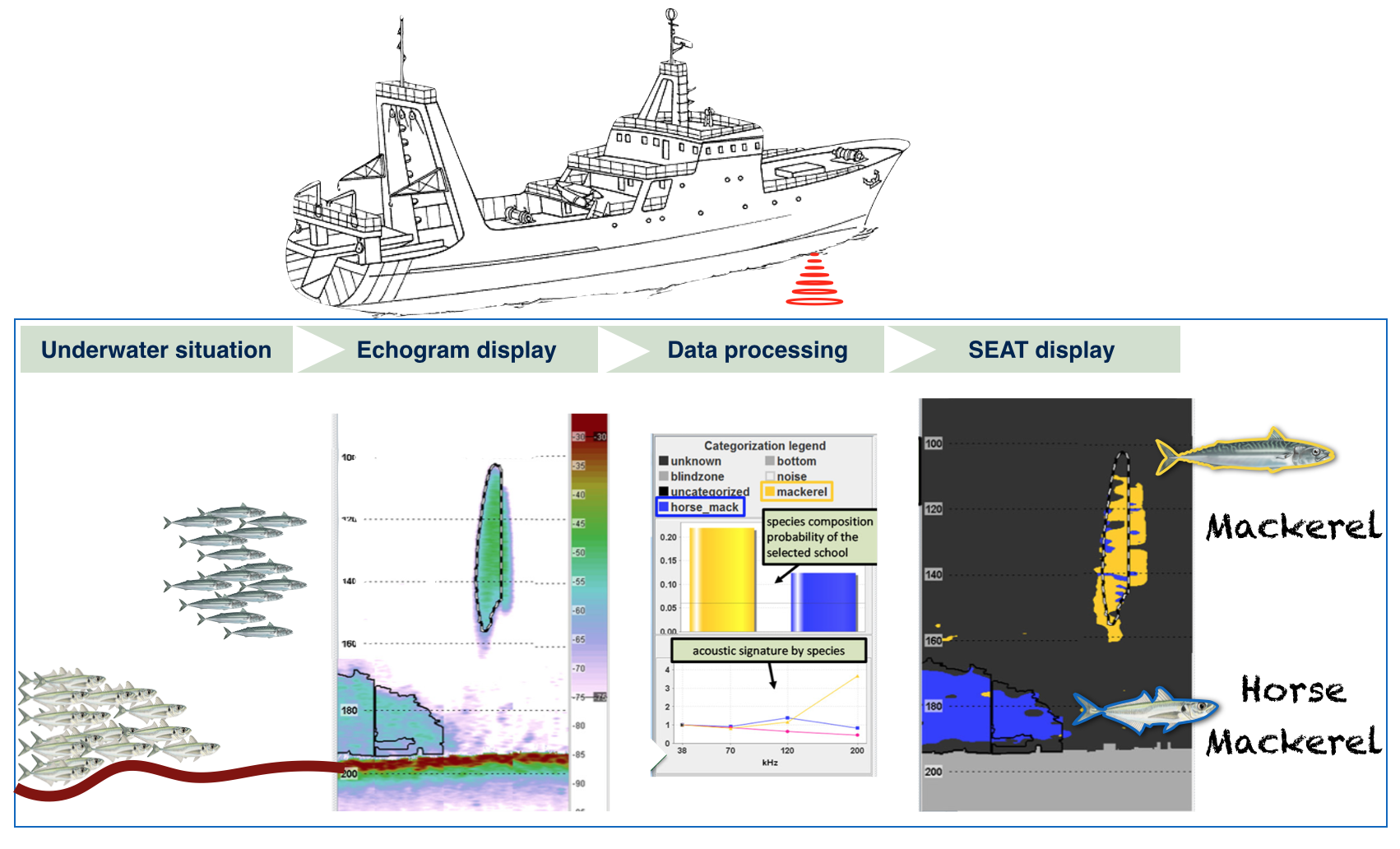
W. van der Zwan & Zn. B.V. (The Netherlands)
Fishing company ‘W. van der Zwan’ is a Dutch owned family enterprise with a pelagic fleet of 3 freezer trawlers. For the purpose of this project, the company prepared their trawler ‘Alida’ (SCH6) and installed scientific echosounders accompanied with SEAT classification software. Van der Zwan has the following responsibilities:
- Installation of equipment necessary for the project;
- Maintenance of the acoustic system that includes annual calibration of echosounders;
- Data recording;
- Data delivery;
- Providing usable feedback on SEAT performance and project progression. This feedback is of crucial importance to the project for further roll-out of the SEAT product in pelagic fleets.
Wageningen IMARES (The Netherlands)
IMARES (Institute for Marine Resources and Ecosystem Studies) is the Netherlands research institute established to provide the scientific support that is essential for developing policies and innovation in respect of the marine environment, fishery activities, aquaculture and the maritime sector.
Christian Michelsen Research (IMR) (Norway)
CMR Computing is a research department for applied research in visualization, data analysis and decision support. It works closely together with industry and government to develop innovative solutions and software prototypes in application areas such as shipping, offshore and fisheries/aquaculture. CMR will have the responsibility over SEAT software development and will provide second line support to the skippers.
CMR and Wageningen IMARES bring in the expertise in implementation of classification algorithms developed by the scientific community. Sustainovate in addition ensures that the above-mentioned technologies are in line with to the company’s business needs and can count on long lasting support from software solution providers. Combination of these two forces can facilitate fishing company W. van der Zwan in achieving its ambition to actively improve selectivity.
Sustainovate AS (Norway)
Sustainovate is an important Norwegian-Dutch partner for companies in the maritime sector that are looking for practical, sustainable solutions. Such solutions can be software, scientific research, match-making and introducing partners to new technologies and ideas. Sustainovate ensures project management & budgeting, partnership coordination and contributes with substantive expertise in the field of acoustics and fisheries software.
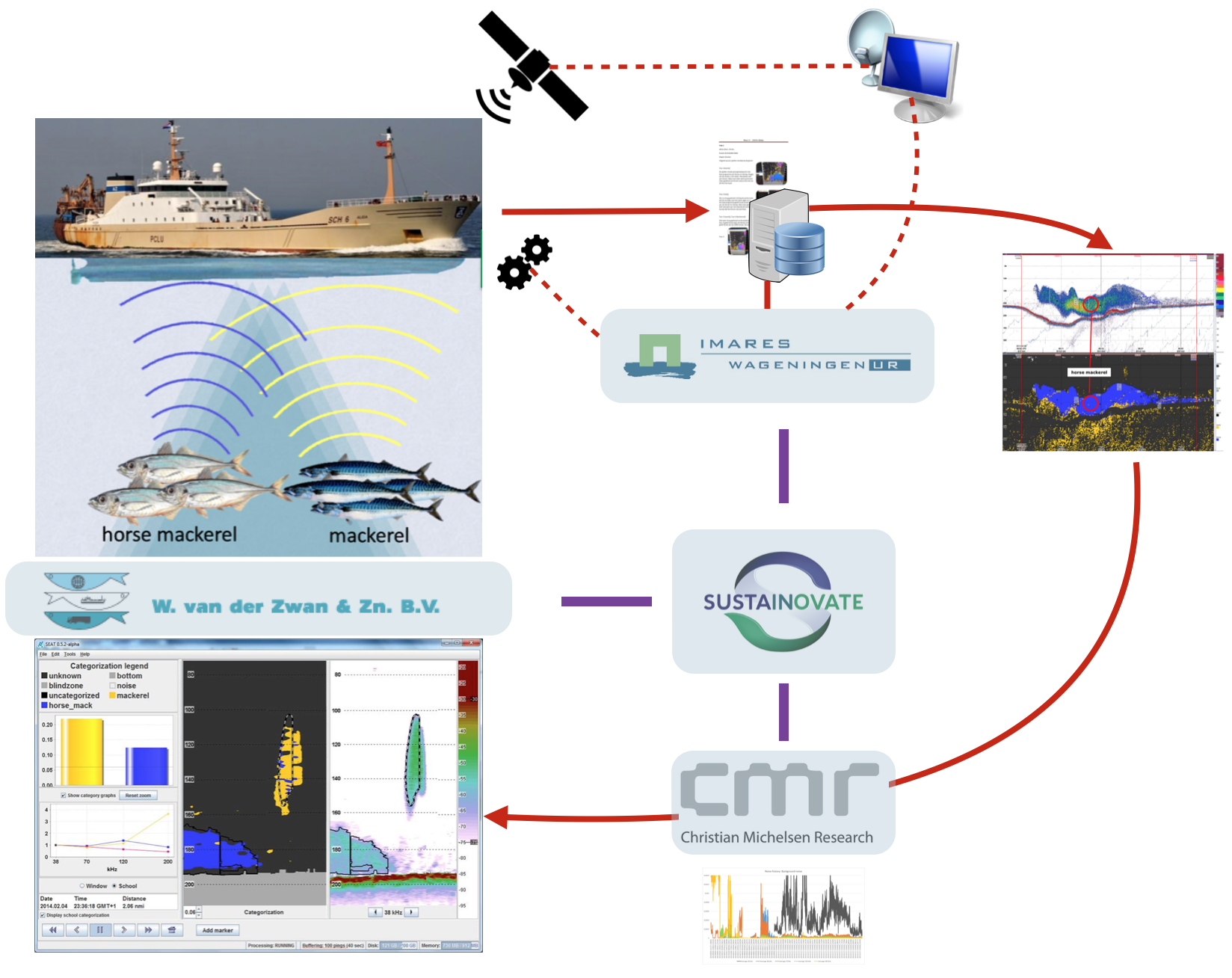
SEAT —> An echosounder signal processor that enables skippers to distinguish pelagic species in areas of co-occurrence.
The team has applied the latest scientific and commercial technologies in multifrequency acoustics and automated species classification to avoid unwanted bycatch during normal fishing operations.
The technology uses the differences in acoustic reflections across the frequency range of echosounders to tell the difference between species.
The acoustic identification approach makes use of variations in sound reflection properties at different frequencies between the fish species investigated. Fish with swimbladders, like horse mackerel, usually show less variation in sound backscatter at the four frequencies used. Mackerel has no swimbladder and is therefore generally a weak scatterer of sound. However, mackerel reflect sound stronger at higher frequencies (>100 kHz) compared to lower frequencies. This feature is used here in the development of an identification algorithm for automated mackerel and horse mackerel school characterisation.
Environmental circumstances will affect the acoustic reflections, but things become much more complicated when the schools of fish consists of more than one species. That is where the research part comes into play. SEAT uses reference data from multiple schools, collected by various vessels at various locations and throughout the year to create a more complete representation of the variation of the fingerprints. When you can compare the acoustic fingerprint of a school to fingerprints from other schools you have already caught (and already know what species it where), you can make a prediction on the species composition.
SEAT is trained on schools with single species composition. If however a school consists of two species which are separated in space (e.g. the lower part is mackerel and the upper part is horse mackerel), the school should have two colours in the categorized echogram corresponding to the colours of the species. If the two species are well mixed, the acoustic backscatter and the SEAT result will be mainly influenced by the acoustically dominant species.
Upgrading of echosounders to scientific standard
- Upgraded existing acoustic hardware to meet scientific standards
- Expansion of data collection system with additional acoustic frequencies to improve reliability
- Scientific calibration of the entire acoustic system
- Installation of additional hardware for running SEAT
Technical adaptations to improve acoustic data quality
- Earthing
- Electrical noise picked up from machines in the fish factory through nearby cables
- Acoustic ‘pings’ picked up from other echosounder and sonars system
- Smoothing the acoustic image by correcting for vessel motion
Below some examples of noise picked up by the echosounder

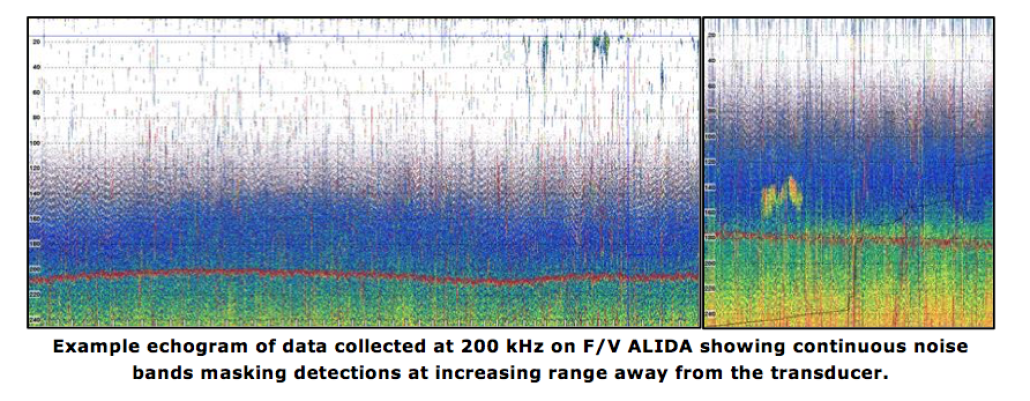

A. Results of ship modifications
Noise on the echosounders has been greatly reduced
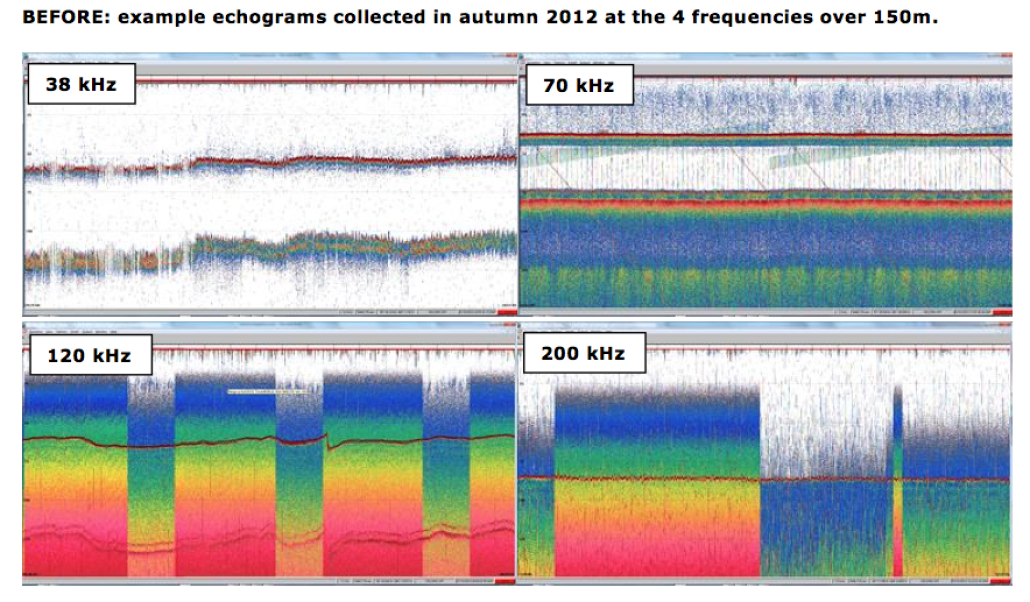
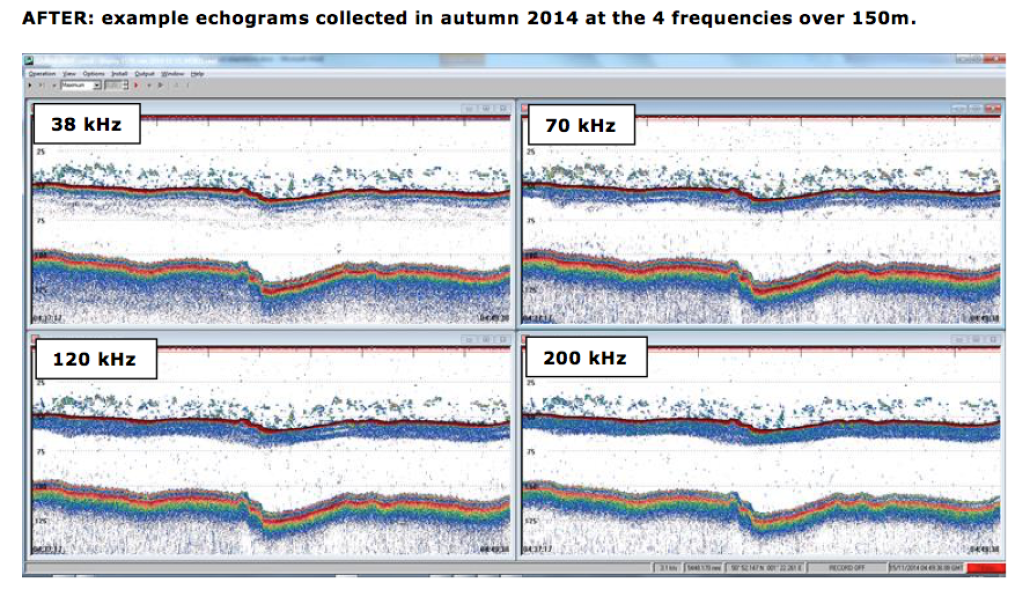
B. Results of SEAT
This section will be updated in January 2015.
Project progression
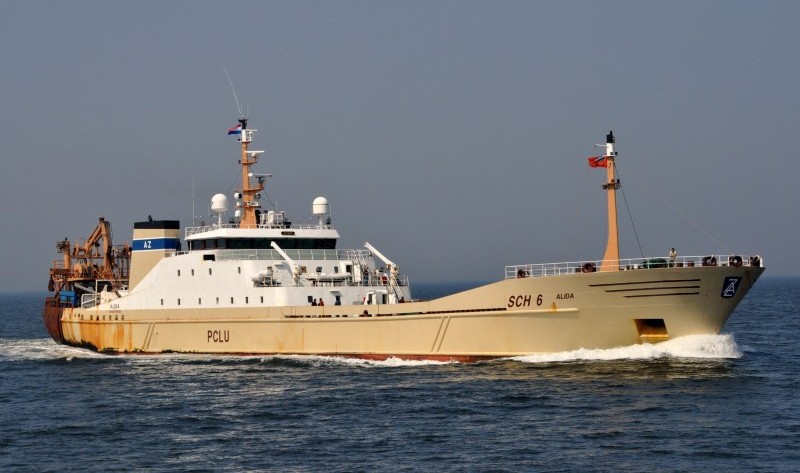
- Project name: SEAT or “Towards improved selectivity of atlantic mackerel and horse mackerel using scientific acoustic species identification methods
- Project duration: (2012) 2013-2014
- Project budget: EUR 684.000
- Funding source: Dutch scientific fishing quota for mackerel and horse mackerel
- Partners: W. van der Zwan, CMR, IMARES, Sustainovate
- Test vessel: F/V Alida (View on Marine Traffic), owned by W. van der Zwan
- Unforeseen costs for re-fitting acoustic system onboard: EUR 60.000.
- Echosounder frequencies used for this project: 38-70-120-200kHz
- Additional hardware installed: MRU 3 – The Heave, Roll and Pitch Motion Sensor (View info sheet).
[useyourdrive dir=”0B0Vo_ZGQow49b1lwVEU1TjB1R1U” mode=”files” viewrole=”administrator|editor|author|contributor|subscriber|guest” showfolders=”0″ filesize=”0″ filedate=”0″ filelayout=”list” showext=”0″ showcolumnnames=”0″ downloadrole=”administrator|editor|author|contributor|subscriber|guest” showsharelink=”0″ showrefreshbutton=”0″ searchfrom=”selectedroot” showbreadcrumb=”0″ notificationdownload=”1″]




